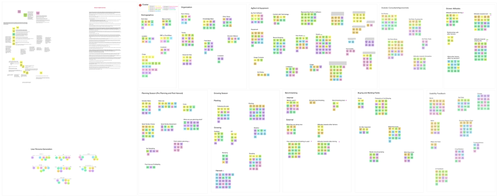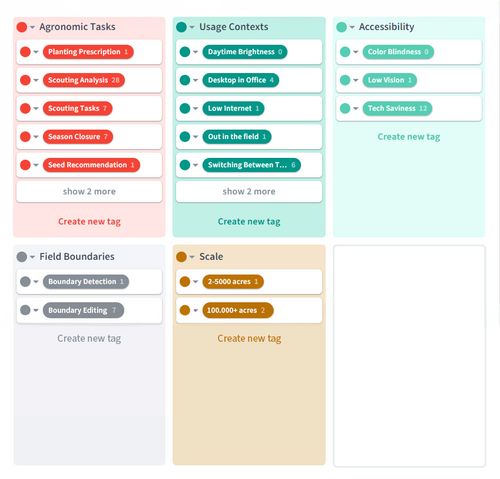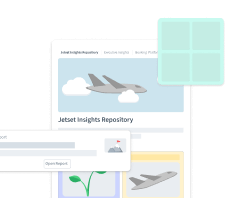
Breaking Down Silos: Syngenta Digital's Path to Centralized Research

The Challenges
- Research was scattered all over the place.
- Difficult to extract concise insights from the analysis process.
- Insights were underutilized and difficult to access for an international team.
The Solution
- Easily publish and share research reports.
- Fully utilize existing research from past interviews and studies.
- Accommodate various research practices across projects and departments.
The Results
- Enhanced collaboration fosters informed decision making.
- The user research process is simplified and more efficient.
- Research insights from different sources are easy to bring together and analyze.
About the company
Syngenta is a global science-based agricultural technology company headquartered in Switzerland, with a mission to help farmers worldwide grow safe and nutritious crops.
With 50,000 employees in over 90 countries, Syngenta is transforming the farming industry, by providing seeds and crop protection technologies.
Syngenta Digital focuses on developing professional solutions that align with customer needs and expectations, and actively engages in user research to achieve this. Nathalia Ilovatte, Content Designer at Syngenta Digital, and Nick Alonso-Emanuel, Lead Product Designer at Syngenta, have played key roles in developing and enhancing the company's user research practices. Let's dive into Syngenta Digital's user research journey!


The Challenges
At the outset of research practices at Syngenta Digital, the team was faced with a situation where user research practices had different maturity levels across different locations with no means of centralizing data. This was particularly challenging for a large, global team with many departments around the world operating within a niche market.
The existing approach made it difficult to access, learn from, and apply research findings across products, initiatives, and teams.
In addition to the need for a more centralized place for user research, Syngenta Digital encountered a further challenge - the management of multiple research topics on Mural boards, each of which contained a large amount of Post-it notes.
Just to give you an example:

As the design team explored a wide variety of subjects, these boards quickly turned into cluttered and unwieldy collections, making it difficult to understand for those not directly involved in the research. Despite the wealth of valuable information present, extracting concise insights was a time-consuming and frustrating task.
„You know the best kind of research is something that you can use to inform multiple projects and multiple teams. You want to be as efficient with your research as possible and we really weren't able to do that before we had Condens.“
To sum it up, Syngenta Digital faced two key challenges in its user research practices:
Their research was spread all over the place with no central place to go, leading to underutilized research where insights were difficult to access.
It was extremely hard to extract concise insights from the analysis process, especially for stakeholders who were not directly involved.
That's when the design team recognized the need for a research repository to streamline the analysis process and grant access to user research findings for all who required it. It marked a turning point in their research journey.
The Solution
In late 2022, the design leadership recognized and took on the challenge of selecting and implementing a research repository at Syngenta Digital with a clear goal: to improve user research practices by having a central and easily accessible place for all insights.
The journey began with an exploration of different repository tools. Members of the team conducted a thorough evaluation, which involved scheduling demos and hands-on testing of several tools. Ultimately, they opted for Condens (surprise).
Let's take a closer look at the decision-making process that led to this choice.
Portuguese transcription capabilities
For an organization with a global team conducting interviews in both English and Portuguese, a key requirement for the repository was the automatic transcription of audio and video recordings in Portuguese. Nick and the team experimented with different tools but faced challenges, requiring manual verification and correction of transcriptions. With Condens, the Portuguese transcription feature proved accurate and efficient, saving time and resources. Consequently, Condens' Portuguese translation capabilities significantly influenced their decision.
Flexibility for diverse research projects
Condens' flexibility was also essential in its selection. The tool's adaptability allowed the design team to use it for a wide range of research projects, including user interviews, competitive analysis, and SME interviews. This flexibility was crucial as research practices vary across departments and projects, with Condens offering the agility needed to accommodate these variations.
„What I really enjoyed was you have a ton of flexibility in how you use Condens.“
Facilitating collaboration and knowledge sharing
The ability to publish research reports and easily share them with stakeholders through a public link was another decisive factor. This functionality eliminated the challenge of finding the right research data and insights for stakeholders. With Condens, they obtained accessible links to the research, streamlining communication and fostering informed decision-making.
The Implementation
To kickstart the implementation process, ten additional designers were added as Condens users to initiate new research projects. With its user-friendly interface and intuitive design, the need for extensive training or repetitive explanations was minimal. Condens seamlessly integrated into the research workflow of the design team, facilitating an easy adoption phase. As teams began to use Condens, its value became apparent, encouraging more and more departments to adopt it.
„I was prepared to explain Condens over and over again to the entire product team and stress how important it was to use it, but I didn't have to. I introduced it once in our daily meeting and everyone asked for access to directly check available reports and add comments, and it just moved forward organically.“
Nick and Nathalia describe this transition as a major success for Syngenta Digital. They shifted from a state of scattered research to a streamlined, efficient, and centralized approach. Condens not only made their research more accessible but also improved its quality and impact, thereby facilitating cross-team collaboration and knowledge sharing. The numbers speak for themselves:
The Results
By introducing Condens as their research repository and research analysis tool, Syngenta Digital’s design team is supported in a variety of ways.
Simplified user research for improved efficiency
Nick and Nathalia highlight Condens' simplification of user research. Previous challenges, such as the tedious process of translating transcripts into Post-its and conducting manual analysis are now a thing of the past. Thanks to Condens, they easily upload interviews and find important insights without losing any valuable information in the process. Nathalia especially appreciates the AI-generated summaries in Condens, which recap key parts of a Highlight, sparing her from sifting through every detail.
Enhanced collaboration and knowledge sharing
They also stress that sharing their research findings with the team, especially the product managers, has become much more convenient with Condens. It allows them to quickly find and understand important information from their interviews. In short, Condens makes user research at Syngenta easier and more transparent, and it helps the whole team understand its value.
Optimized tracking of participants and interactions
When asked about their favorite features, Nick highlights the participant management in Condens, which is invaluable for tracking interactions. This is especially useful as Syngenta operates in a niche market with few potential research participants and various teams reaching out to the same people. The participant panel in Condens helps them to prevent duplicate communication and enhance understanding of past engagements.
Real-Life Application
To provide a more comprehensive view of how Condens is integrated into Syngenta's research practices, Nick and Nathalia shared two ongoing use cases of how they leverage the tool to streamline their daily user research operations and enhance productivity.
Synergizing user research data in Condens as shared by Nick
Syngenta's design team is currently developing a new tool feature aimed at assisting farmers in managing crucial farming data, including planting schedules and fertilizer applications. To ensure a well-informed approach, they used Condens to collect, analyze, and synthesize all relevant information from multiple sources. See how Nick and the team benefited from using Condens:
- Easily bring together research insights from different sources: competitor analysis, expert interviews, and user feedback.
- Eliminate the need to switch between different tools or platforms.
- Ensure a smooth and productive research process integral to project development.
Accessing existing user research in Condens as shared by Nathalia
In a recent design project, one of Syngenta's designers had many questions about an important feature, but no clear answers. Instead of conducting new, more time-consuming research, the designer asked Nathalia for help. And this is where Condens came in handy. The team did not have to start from scratch but used Condens to access information from previous interviews and studies.
- Instead of initiating new research, they leveraged Condens to access information from past interviews and studies.
- This enabled them to understand user interactions with the feature and their expectations.
- It also prevented the need for starting a new research cycle, avoiding duplication of questions and efforts.
Final Advice
In discussing the implementation and adoption of a research repository, Nick and Nathalia shared some valuable advice for organizations that may also be considering going down the same path:
1) Utilize Global Tags
Use Global Tags for common terms or concepts, especially if you work in multiple languages. This will help in finding relevant information, even when the primary language is English.

2) Internal Tags for regional context
Create internal tags for specific research conducted in different languages or regions. This allows you to maintain regional context and helps you easily identify and access relevant data.
3) Define tagging standards
Establish clear tagging standards within your team. Decide what constitutes a tag, whether it's a whole paragraph, specific keywords, or something else. Consistency is key for effective analysis.
4) Share and collaborate
To ensure your research is accessible to the whole team, make use of sharing features. Publish reports, use easy-to-share URLs, and encourage team members to distribute the information within and outside the organization.
5) Maximize visibility
Take advantage of URL sharing, allowing others to access research without requiring a login. This increased visibility can lead to greater collaboration and insights.
Want to learn more about UX research repositories? Check out Condens' introductory guide on research repositories and discover the article about what a UX research repository can do for you.




